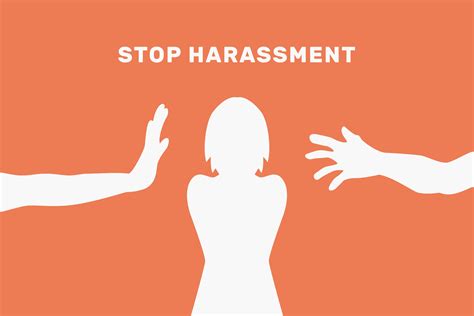
**Report Workplace Harassment**
Harassment on the job can take a toll, both personally and professionally. If you’re dealing with it, you may feel isolated and powerless. However, there are resources available to help you. One of the most important steps you can take is to report workplace harassment. This guide will provide you with the information you need to do so.
**Types of Workplace Harassment**
There are two main types of workplace harassment: quid pro quo harassment and hostile work environment harassment.
**Quid Pro Quo Harassment**
Quid pro quo harassment occurs when someone in a position of power, such as a supervisor or manager, makes a job benefit contingent on sexual favors. This can include promises of promotions, raises, or other benefits in exchange for sexual activity. Quid pro quo harassment is illegal and should be reported immediately.
**Hostile Work Environment Harassment**
Hostile work environment harassment occurs when the conduct of a coworker or supervisor creates an intimidating, hostile, or offensive work environment. This can include unwelcome sexual advances, jokes, or comments, as well as physical or verbal abuse. Hostile work environment harassment is also illegal and should be reported.
It’s crucial to recognize that harassment can take many forms. It’s not always overt or physical. Subtler forms of harassment, such as spreading rumors or excluding someone from social activities, can also be damaging. If you’re experiencing any type of harassment, don’t hesitate to report it.
**How to Report Workplace Harassment**
If you’re experiencing workplace harassment, there are several ways to report it. You can:
* **Report it to your supervisor or manager.**
* **File a complaint with your company’s human resources department.**
* **Contact your union representative.**
* **File a complaint with the Equal Employment Opportunity Commission (EEOC).**
When you report workplace harassment, be sure to provide as much detail as possible. This includes the date, time, and location of the harassment, as well as the name of the person who harassed you. You should also keep a record of all communication with your employer about the harassment.
**What to Expect After You Report Harassment**
Once you report workplace harassment, your employer is required to investigate the complaint and take appropriate action. This may include issuing a warning to the person who harassed you, disciplining them, or even firing them.
If you’re not satisfied with the outcome of your employer’s investigation, you can file a complaint with the EEOC. The EEOC can investigate your complaint and take legal action on your behalf.
**Resources for Victims of Workplace Harassment**
If you’re experiencing workplace harassment, there are several resources available to help you. You can contact the following organizations for support:
* **The National Sexual Violence Resource Center (NSVRC):** 1-800-656-HOPE
* **The Rape, Abuse & Incest National Network (RAINN):** 1-800-656-HOPE
* **The Equal Employment Opportunity Commission (EEOC):** 1-800-669-4000
These organizations can provide you with information, support, and resources to help you cope with workplace harassment.
Reporting Workplace Harassment
Experiencing workplace harassment can be a distressing and intimidating situation, but it’s crucial to address it promptly. If you’re facing this issue, consider reporting it to your supervisor or a trusted colleague. Seeking support from someone within the organization can initiate the process of resolving the harassment and protecting your well-being.
Gathering Evidence
Documenting the instances of harassment is essential for building a strong case. Keep a detailed record of the dates, times, and specific behaviors you experienced. Include any witnesses or evidence, such as emails, text messages, or social media posts, that support your claims.
Choosing the Right Reporting Channel
Most organizations have established reporting mechanisms for handling harassment complaints. Check your company’s policies or speak to your HR department to identify the appropriate channel. Reporting to a supervisor or manager is often the first step, but you may also consider seeking support from an external body like an ombudsperson or government agency if necessary.
What to Expect After Reporting
Upon reporting the harassment, expect the organization to conduct an investigation. They will likely interview you, the alleged harasser, and any witnesses. The investigation’s purpose is to gather facts and determine if the alleged behavior constitutes harassment. Depending on the findings, the organization may take appropriate disciplinary action or implement measures to prevent future incidents.
Report Workplace Harassment
Workplace harassment is a serious issue that can create a hostile work environment and make it difficult to perform your job. It can take many forms, from verbal abuse to physical assault. If you are experiencing harassment at work, it is important to report it to your supervisor or another trusted person. Here are a few steps you can follow to report workplace harassment.
Gather Evidence
The first step in reporting workplace harassment is to gather evidence. This may include emails, text messages, or witness statements that document the harassment. It is important to be as specific as possible when documenting the harassment, including the dates, times, and locations of the incidents. If you have any physical injuries, be sure to seek medical attention and document the injuries.
Talk to Your Supervisor or Another Trusted Person
Once you have gathered evidence, you should talk to your supervisor or another trusted person about the harassment. This could be a human resources representative, a union representative, or a coworker who you trust. It is important to be clear and concise when describing the harassment, and to provide as much detail as possible. Be sure to mention the evidence you have gathered.
File a Formal Complaint
If you feel comfortable doing so, you can file a formal complaint with your employer. This will typically involve submitting a written statement describing the harassment, along with any evidence you have gathered. Your employer is required to investigate the complaint and take appropriate action. This action may include providing you with a safe work environment, disciplining the harasser, or firing the harasser.
Follow Up
After you have filed a complaint, it is important to follow up with your employer to make sure that the investigation is being conducted properly and that appropriate action is being taken. You should also keep a record of all communications with your employer about the harassment. If you are not satisfied with the outcome of the investigation, you may want to consider filing a complaint with a government agency, such as the Equal Employment Opportunity Commission (EEOC).
**Report Workplace Harassment**
Have you ever witnessed or experienced inappropriate behavior in your workplace? If so, you must report it. Reporting workplace harassment is essential to ensure a safe and respectful work environment for all. It is not only the right thing to do, but it also has numerous benefits for both the individual and the organization.
**Benefits of Reporting Workplace Harassment**
* **Protecting Yourself:** Firstly, reporting harassment protects you from further victimization. When you report, you document the incident which helps build a case if the behavior persists. This evidence can help you hold your harasser and/or the organization accountable.
* **Protecting Others:** By reporting harassment, you are not only advocating for yourself but also for others who may be vulnerable to similar behavior. By creating a safe and respectful atmosphere, you are ensuring that everyone feels comfortable and respected at work.
* **Hold the Harasser Accountable:** Reporting harassment empowers you to hold the harasser responsible for their actions. It sends a clear message that such behavior is unacceptable and will not be tolerated.
* **Foster a Positive Work Environment:** When workplace harassment is addressed effectively, it promotes a sense of justice and fairness. It creates a culture where employees feel safe to speak up and report any inappropriate behavior.
* **Legal Protection:** Many jurisdictions have laws in place to protect individuals from workplace harassment. Reporting harassment ensures that your rights are upheld and can help you pursue legal remedies if necessary.
**How to Report Workplace Harassment**
1. **Gather Evidence:** Document the details of the harassing behavior, including dates, times, witnesses, and any relevant communication.
2. **Report to the Appropriate Party:** Report the harassment to your supervisor, human resources department, or any other designated reporting mechanism within your organization.
3. **Follow Up:** After reporting, follow up to ensure that your complaint is being taken seriously and appropriate action is being taken.
Remember that you have the right to work in a safe and respectful environment. Reporting workplace harassment is not only the right thing to do, but it also benefits you, your colleagues, and your organization as a whole. Don’t hesitate to speak up and report any inappropriate behavior.


